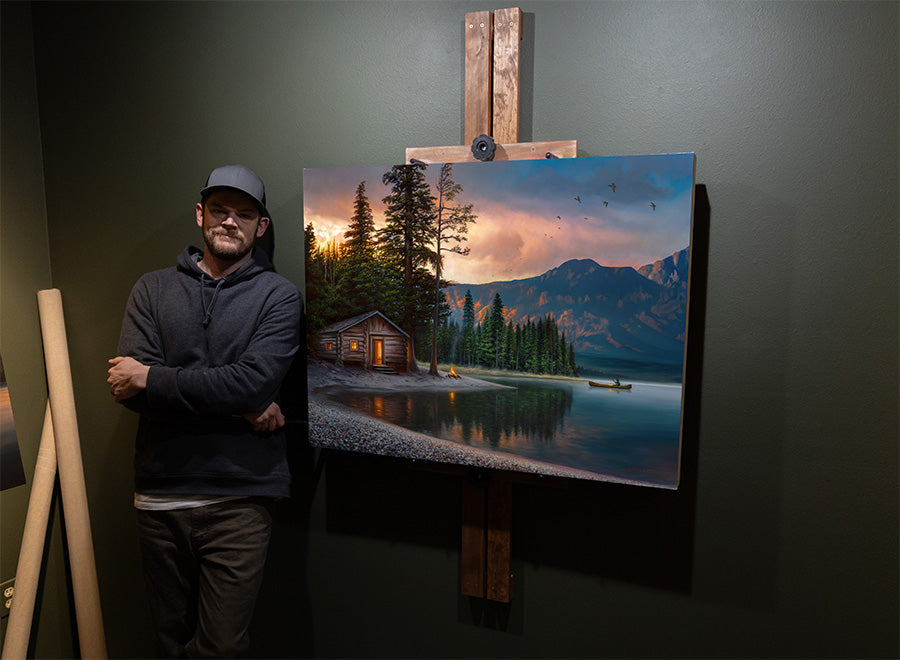This blog is supported through the affiliate links below
Mastering Composition: Using the Rule of Thirds for Stunning Artworks and Landscapes
As an artist, I have always been obsessed with trying to create captivating artworks. Over the years, I have discovered various techniques and principles that have helped elevate my abilities to capture a stunning image. One such principle that I have come to realize its importance is the rule of thirds.

Note: This blog contains affiliate links and purchasing through them supports our site at no extra cost to you.
What is the rule of thirds?
The rule of thirds is a fundamental compositional guideline commonly used in photography and visual arts. It works by dividing an image into nine equal parts, using two horizontal and two vertical lines, creating a grid. By aligning key elements along these lines or at their intersecting points, the rule of thirds helps create balanced, engaging compositions. It enhances visual interest, harmony, and provides a framework for creating both depth and perspective in the artwork.

Understanding the rule of thirds
The points at which these lines intersect are commonly referred to as "power points." By aligning key elements of your composition with these power points or along the lines themselves, we can create more balanced, engaging images.
Placing important elements of your artworks off-center rather than in the center of the frame allows for more visually pleasing and compelling compositions. This technique can aide in capturing your viewer's attention and guide them along a more interesting visual journey.

Adding your focal points or other significant elements along the grid lines or at the intersecting points creates a sense of stability and helps you avoid a static or unbalanced image. This balance creates a visual rhythm that often resonates with the viewer, leading to a more satisfying experience that is sure to leave an impact.
It's very helpful in landscapes to use these gridlines to establish a foreground, middle ground, and background, This technique can draw the viewer deeper into the scene, invoking a more emotional and immersive experience.

How to use the rule of thirds?
Now that we understand the benefits of the Rule of Thirds, let's explore some practical ways to incorporate it into our artistic process. Now, my expertise is more in landscapes and so that's what we'll cover mostly.
But briefly, how can we use the rule of thirds for other things like say, portraits or figures? Think about what's most powerful in a portrait first. Positioning things like the subjects' eyes along the upper horizontal line or near the power points can be a sure way to enhance the composition. Additionally, when depicting figures, aligning prominent body parts or points of interest with the grid lines can be a great way to accomplish a strong, engaging image as well.
So, what about still life or even abstract? In the same way, you should think about what the most standout or eye-catching features of your subjects are and try placing them at these points or lines. Get creative with it and think of ways to even guide your viewers eye towards an intersecting point if it's difficult to place something exactly on it.

How to use the rule of thirds in landscapes?
Establishing a Focal Point: In landscape painting, you can use the rule of thirds to determine the placement of your focal point. Identify the most captivating element in your scene which could be a mountain peak, a large tree, or an animal. Rather than placing it in the center, position it along one of the vertical grid lines or at one of the intersecting points. This off-center placement will help you add visual interest and draw the viewer's attention to that focal point. By following this to some degree, you will help create a dynamic composition within your landscape as a whole
Creating Depth and Perspective: You can harness the power of using these gridlines to capture more believable perspective in your landscapes. For example, place the foreground elements, such as rocks or flowers, along the lower third line. The middle ground, such as hills or trees, could be placed along the horizontal grid lines, while the background elements, such as distant mountains or the sky, can be positioned along the upper third line. This specific arrangement helps bring the viewer a feeling of spatial depth.
Balancing Elements: Similar to photography, the rule of thirds helps achieve balance in landscape painting. By placing key elements across the grid lines and intersecting points, you create a balanced composition that feels natural and also aesthetically pleasing. Avoid placing significant elements in the center, as it may result in a static and less engaging landscape composition.

Now, it's important to remember that the rule of thirds is just a guide and should not be taken as a rigid rule. It can be adjusted and adapted based on your artistic vision or perhaps the requirements that it takes to execute a certain painting. Experiment with different placements and variations to find what works best for you and your style of artwork. The more you use it and reference it, the more comfortable you'll become. As you become comfortable, you'll begin to gain the ability to bend these rules without hurting your viewer's experience, leading to more powerfully composed artworks.
Grow Your Painting Skills and Resources
Instant access to 1000s of royalty-free reference photos of landscapes and wildlife as well as step by step oil painting videos. Checkout My Memberships for more info.

I'm Chuck Black, landscape and wildlife artist based in Southwest Montana.





